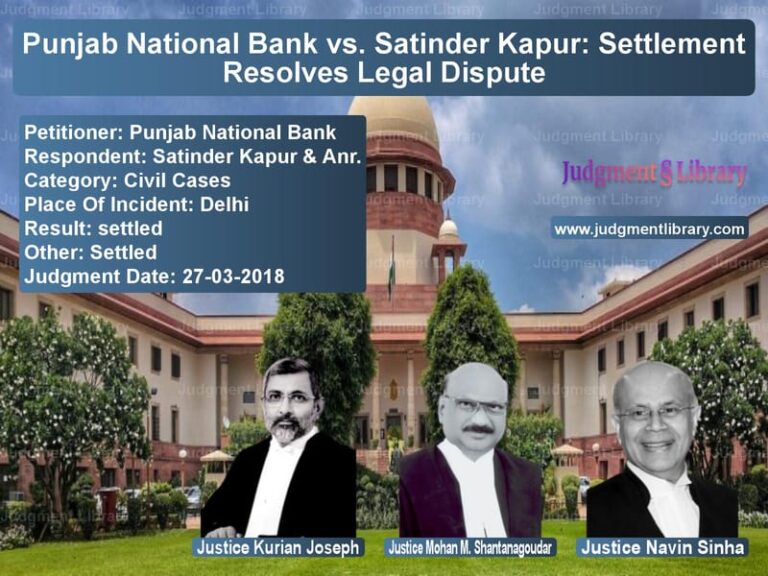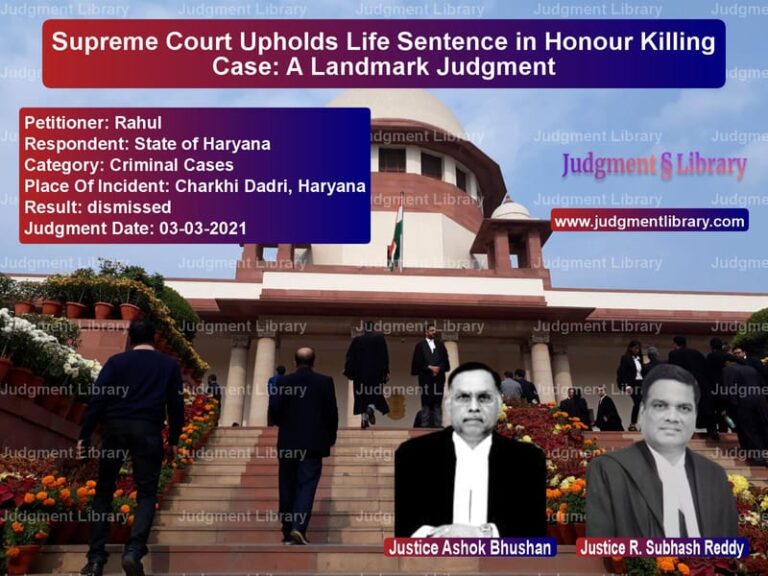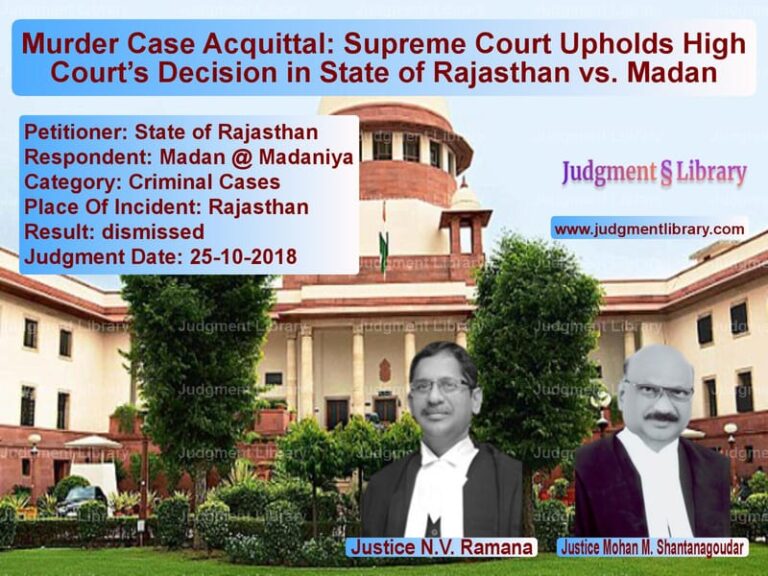Uphaar Fire Tragedy Case: Supreme Court Quashes Criminal Proceedings Against Former DCP
The Supreme Court of India recently delivered a crucial verdict in the case of Amod Kumar Kanth vs. Association of Victims of Uphaar Tragedy & Anr., concerning the tragic Uphaar Cinema fire of 1997. The case revolved around the role of Amod Kumar Kanth, a former Deputy Commissioner of Police (DCP), in allegedly permitting additional seats in the cinema hall, which were later deemed to have contributed to the fire disaster. The Court ultimately quashed the criminal proceedings against Kanth, ruling that no prosecution could be initiated without prior sanction under Section 197 of the Code of Criminal Procedure (CrPC).
Background of the Case
On June 13, 1997, a devastating fire at Uphaar Cinema in Delhi resulted in the deaths of 59 people and injuries to over 100 others. The fire was attributed to a short circuit in a transformer maintained by the Delhi Vidyut Board (DVB). However, a major factor that exacerbated the disaster was the presence of unauthorized seats, which obstructed the evacuation process.
The Association of Victims of Uphaar Tragedy (AVUT) alleged that Amod Kumar Kanth, who served as DCP (Licensing) in 1979-80, had allowed the installation of additional seats in the cinema hall. They contended that this action directly contributed to the high casualty count during the fire. The AVUT filed a protest petition challenging the Central Bureau of Investigation’s (CBI) closure report, leading to the Magistrate taking cognizance and summoning Kanth under the following charges:
- Section 304A (Causing death by negligence) of the Indian Penal Code (IPC)
- Sections 337 and 338 of the IPC (Causing hurt and grievous hurt by an act endangering life or personal safety)
- Section 14 of the Cinematograph Act, 1952
Kanth subsequently moved the Delhi High Court under Section 482 of the CrPC, seeking to quash the criminal proceedings. However, the High Court dismissed his plea, prompting him to approach the Supreme Court.
Arguments of the Petitioner
Senior Advocate R. Basant, appearing for Kanth, raised three key arguments:
- Lack of Sanction Under Section 197 CrPC: It was contended that Kanth was a public servant and was performing his official duty when the additional seating arrangement was made. As per law, no court could take cognizance of the offense without prior sanction from the competent authority.
- Time Gap Between the Alleged Act and the Tragedy: The additional seats were approved in 1979-80, whereas the fire occurred in 1997. Kanth had long ceased to hold the relevant position, and several inspections had been conducted by different authorities over the years.
- Procedural Irregularities: The trial court had ordered further investigation under Section 173(8) of the CrPC after the conclusion of the original trial against other accused persons, which was impermissible under law.
Arguments of the Respondents
On the other hand, Senior Advocates K.T.S. Tulsi and Aparajita Singh, appearing for AVUT and the CBI, countered the petitioner’s claims:
- They argued that Kanth had deliberately allowed additional seats despite knowing the safety hazards, thus contributing to the tragedy.
- The investigation had revealed that Kanth had taken a rigid stance against removing the unauthorized seats.
- Given the magnitude of the tragedy, criminal liability must be affixed to all those responsible, including officials who enabled the conditions that led to the disaster.
- Even if the prosecution required sanction under Section 197 CrPC, the Court could direct the government to reconsider and grant such sanction.
Supreme Court’s Key Observations
The Supreme Court bench, comprising Justices K.M. Joseph, B.V. Nagarathna, and Aravind Kumar, made the following observations:
- “The most important question which must be posed and answered is whether the officer was acting in the exercise of his official duties. Even if an officer acts in the purported exercise of his official power, he is given protection under Section 197 of the CrPC.”
- “The law mandates that once the person against whom cognizance is taken was holding a public office and the act attributed to him is done in the discharge of his official duties, cognizance cannot be taken without prior sanction.”
- “There may have been lapses in enforcement, but the prosecution of a public servant must be preceded by due sanction from the competent authority, which was absent in this case.”
- “The role of oversight agencies and their repeated inspections over 17 years must also be considered. If the licensing authority continued to approve the cinema’s functioning, the blame cannot be singularly placed on an officer who acted in 1979.”
Final Judgment
Based on these findings, the Supreme Court ruled in favor of Kanth and quashed the criminal proceedings against him. The Court held:
- “In the absence of sanction under Section 197 CrPC, the prosecution of the appellant cannot be sustained.”
- “The proceedings challenged in Section 482 will stand quashed.”
- “However, this will not prevent the competent authority from reconsidering the matter and granting sanction if deemed appropriate.”
Implications of the Judgment
The Supreme Court’s ruling in this case has significant implications for public servants and the principle of accountability:
- Reaffirmation of Sanction Requirement: The judgment reinforces that public servants cannot be prosecuted for acts done in their official capacity without prior government approval.
- Protection Against Misuse of Criminal Law: It prevents arbitrary prosecutions against officials who performed their duties in good faith.
- Importance of Institutional Accountability: The ruling highlights that liability for systemic failures should be spread across all responsible agencies rather than targeting individuals selectively.
Conclusion
The Supreme Court’s decision in Amod Kumar Kanth vs. Association of Victims of Uphaar Tragedy underscores the importance of due process in criminal prosecutions of public officials. While the tragedy remains one of the most horrific disasters in India’s history, the Court’s ruling ensures that legal principles, such as prior sanction under Section 197 CrPC, are upheld to prevent unjust prosecutions.
Petitioner Name: Amod Kumar Kanth.Respondent Name: Association of Victims of Uphaar Tragedy and Anr..Judgment By: Justice K.M. Joseph, Justice B.V. Nagarathna, Justice Aravind Kumar.Place Of Incident: Uphaar Cinema, Delhi.Judgment Date: 20-04-2023.
Don’t miss out on the full details! Download the complete judgment in PDF format below and gain valuable insights instantly!
Download Judgment: amod-kumar-kanth-vs-association-of-victi-supreme-court-of-india-judgment-dated-20-04-2023.pdf
Directly Download Judgment: Directly download this Judgment
See all petitions in Bail and Anticipatory Bail
See all petitions in Custodial Deaths and Police Misconduct
See all petitions in Judgment by K.M. Joseph
See all petitions in Judgment by B.V. Nagarathna
See all petitions in Judgment by Aravind Kumar
See all petitions in allowed
See all petitions in Quashed
See all petitions in supreme court of India judgments April 2023
See all petitions in 2023 judgments
See all posts in Criminal Cases Category
See all allowed petitions in Criminal Cases Category
See all Dismissed petitions in Criminal Cases Category
See all partially allowed petitions in Criminal Cases Category







